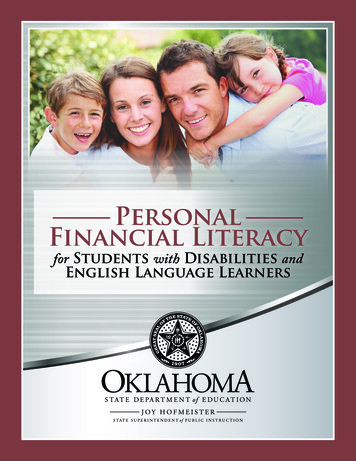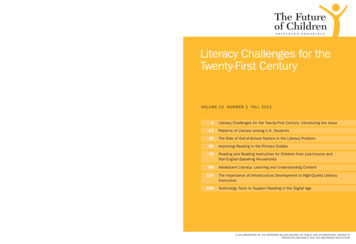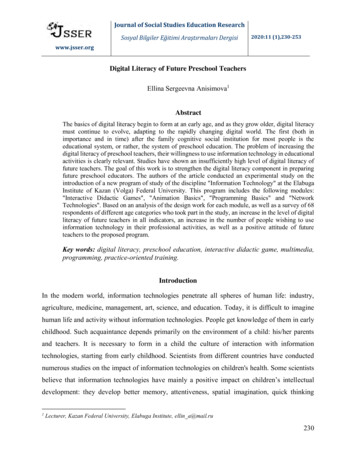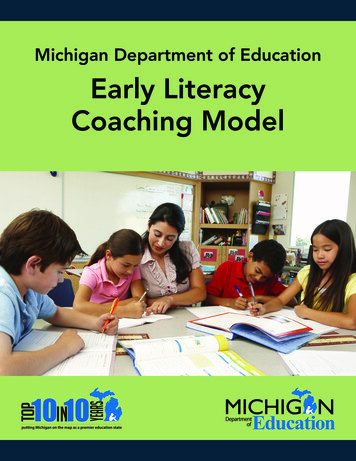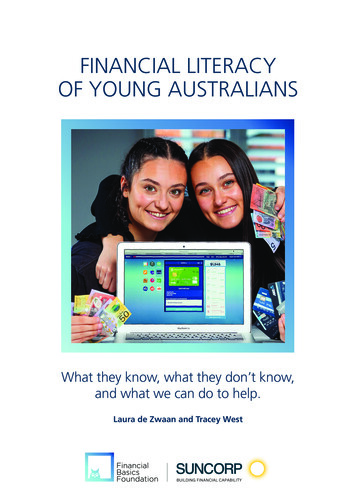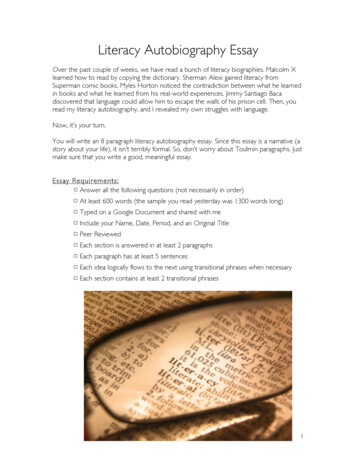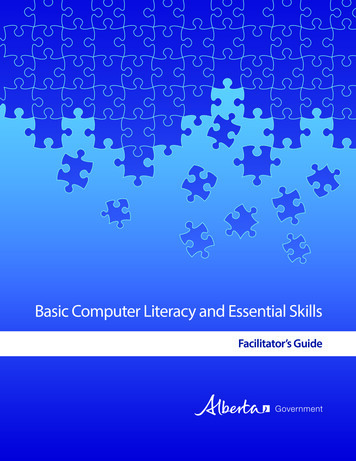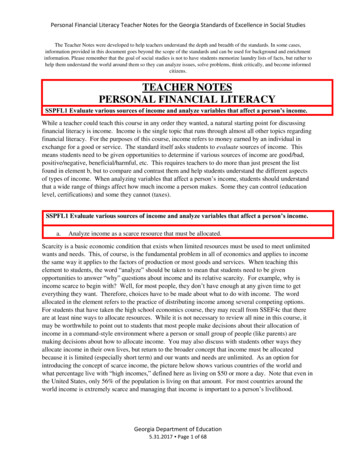
Transcription
Personal Financial Literacy Teacher Notes for the Georgia Standards of Excellence in Social StudiesThe Teacher Notes were developed to help teachers understand the depth and breadth of the standards. In some cases,information provided in this document goes beyond the scope of the standards and can be used for background and enrichmentinformation. Please remember that the goal of social studies is not to have students memorize laundry lists of facts, but rather tohelp them understand the world around them so they can analyze issues, solve problems, think critically, and become informedcitizens.TEACHER NOTESPERSONAL FINANCIAL LITERACYSSPFL1 Evaluate various sources of income and analyze variables that affect a person’s income.While a teacher could teach this course in any order they wanted, a natural starting point for discussingfinancial literacy is income. Income is the single topic that runs through almost all other topics regardingfinancial literacy. For the purposes of this course, income refers to money earned by an individual inexchange for a good or service. The standard itself asks students to evaluate sources of income. Thismeans students need to be given opportunities to determine if various sources of income are good/bad,positive/negative, beneficial/harmful, etc. This requires teachers to do more than just present the listfound in element b, but to compare and contrast them and help students understand the different aspectsof types of income. When analyzing variables that affect a person’s income, students should understandthat a wide range of things affect how much income a person makes. Some they can control (educationlevel, certifications) and some they cannot (taxes).SSPFL1 Evaluate various sources of income and analyze variables that affect a person’s income.a.Analyze income as a scarce resource that must be allocated.Scarcity is a basic economic condition that exists when limited resources must be used to meet unlimitedwants and needs. This, of course, is the fundamental problem in all of economics and applies to incomethe same way it applies to the factors of production or most goods and services. When teaching thiselement to students, the word “analyze” should be taken to mean that students need to be givenopportunities to answer “why” questions about income and its relative scarcity. For example, why isincome scarce to begin with? Well, for most people, they don’t have enough at any given time to geteverything they want. Therefore, choices have to be made about what to do with income. The wordallocated in the element refers to the practice of distributing income among several competing options.For students that have taken the high school economics course, they may recall from SSEF4c that thereare at least nine ways to allocate resources. While it is not necessary to review all nine in this course, itmay be worthwhile to point out to students that most people make decisions about their allocation ofincome in a command-style environment where a person or small group of people (like parents) aremaking decisions about how to allocate income. You may also discuss with students other ways theyallocate income in their own lives, but return to the broader concept that income must be allocatedbecause it is limited (especially short term) and our wants and needs are unlimited. As an option forintroducing the concept of scarce income, the picture below shows various countries of the world andwhat percentage live with “high incomes,” defined here as living on 50 or more a day. Note that even inthe United States, only 56% of the population is living on that amount. For most countries around theworld income is extremely scarce and managing that income is important to a person’s livelihood.Georgia Department of Education5.31.2017 Page 1 of 68
Personal Financial Literacy Teacher Notes for the Georgia Standards of Excellence in Social StudiesResources:Photo above retrieved from: e-class-is-morepromise-than-reality/pg-2015-07-08 globalclass-11/SSPFL1 Evaluate various sources of income and analyze variables that affect a person’s income.b. Compare different types of income including hourly wages, salary, tips, independent contractorservices (Form 1099), dividends, and capital gains.This is a good example of an element that exists to help teach the overarching standard. The standardrequires students to evaluate – make judgements about, determine effectiveness of, etc – sources ofincome whereas the element uses the word compare. You can’t evaluate without first comparing. Inorder to effectively compare (and contrast) these types of income you will need a set of criteria. Asuggested set of criteria is presented in the table below including how the income is earned, frequency ofreceiving income, and potential for increases/decreases. After comparing these types, a suggested activitywould be to present a list of jobs and activities to students and have them decide the best way to paysomeone to complete those activities.Georgia Department of Education5.31.2017 Page 2 of 68
Personal Financial Literacy Teacher Notes for the Georgia Standards of Excellence in Social StudiesIncome TypeHourly wagesSalaryTipsIndependentContractor(1099)How earned?Frequency Guaranteed pay forevery hour worked Agreed to byemployer/employee Varies, but typicalhourly jobs payevery week orevery two weeks Some hourly jobspay in cash at thetime of the job Guaranteed pay for a Most salaried jobsjobpay every twoweeks or once Agreed to byevery monthemployer/employee Not tied to a specific Some salaried jobsalso includeset of hours workedbonuses received atselected times ofthe year “Extra” money given Tips are usually oneas a reward for goodtime offerings andservice or as aare givencustomary show ofimmediatelygratitudefollowing thecompletion of the Tips are usuallyserviceoptional and soley atthe discretion of the Some organizationscustomer“pool” tips from allemployees andredistribute equallyPotential forincreases/decreases Usually hourly wages aresomewhat tied to minimumwage so when that increases,hourly wages may rise Most jobs that pay hourlywages have starting salarieswith potential for increasesafter performance reviews Hourly wage earners are“nonexempt” according tothe Federal Labor Comission,which means there is potentialfor overtime pay Salaries are often negotiatedso any pay raises usuallycome as a result of apromotion or the employeeasking for a raise Salaried employees are“exempt” and do not getovertime pay In theory, tips are incentivebased and can be increasedwith good service Since tips are discretionary,the amount of tips canfluctuate depending on timeof day, day of week, time ofyear, attitude of customer, etc. Income agreed to Payment is usually Pay is usally stated upfront(via legal contractreceived at the endand there are notusually) by aof the job, althoughopportunities to increase orconsumer andsome contractsdecrease it as long as the jobproducer for aallow for partialis completed according to thespecific set ofpayment throughoutcontractservices Payment is job Sometimes incentives are This differs salarybased and does notprovided if certain terms arebecause the producerfollow a setmetis usually not antimeline Payment can be refused if“employee” of theterms of contract are violatedconsumerGeorgia Department of Education5.31.2017 Page 3 of 68
Personal Financial Literacy Teacher Notes for the Georgia Standards of Excellence in Social StudiesDividendsCapital Gains Income earned byholding shares ofstock in a companythat paysshareholders whenprofits are earned Companies that paythem usually have aset schedule withexact dates Typically, dividendpayments are doneevery three months(quarterly) Income earned when Typically a onean investment (stock,time transactionhouse, antique, etc)that only occursis sold for MOREwhen thethan it wasinvestment is soldpurchased for No timeline,investments aretypically held untilthe owner needsincome or themarket for theinvestment is ripefor selling Companies are not legallyrequired to pay dividends andcan stop the practice at anytime During poor economic timesor if the company isperforming badly, dividendpayments often fall. Dividendpayments can rise when thecompany is performing better. Some investments are riskierthan others Stocks can change value dailywhile real estate is slower tochange, but may be tougher tosell Some investments neverincrease in value and canmake the owner lose moneyRemember, the chart above is only a suggestion. You could also compare the types of income in broaderterms using benefits/drawbacks or you could compare how taxes affect the different types. Whicheveryou choose, remember to come back to an evaluation of the types to meet the standard.Resources:Learn more about Form 1099 here: https://www.irs.gov/uac/about-form-1099miscLearn more about capital gains here: pLearn more about dividends here: PFL1 Evaluate various sources of income and analyze variables that affect a person’s income.c. Analyze how career choice, education, skills, and economic conditions are related to income andlevels of unemployment.The direct relationship between education level and income is one of the strongest correlations there is inall of social science. Of course, there are exceptions and students love to point these out: “My [insertfriend/family member] dropped out of [random education level] and he makes tons of money!” Thereason those exceptions are so noteworthy is because of their rarity. For the vast majority of people, thebest way to insure a healthy and stable economic lifestyle is through some sort of skill development. Thatsaid, it is important to stress with students that going to college is not always the path to success. Tradeschools, internships, technical schools, and apprenticeships are also very useful ways of developing skillsand employability. The graphic below is a pretty standard graphic from the Bureau of Labor statistics thatdemonstrates the relationships between education and skills and income and unemployment.Georgia Department of Education5.31.2017 Page 4 of 68
Personal Financial Literacy Teacher Notes for the Georgia Standards of Excellence in Social StudiesThe element also ask students to analyze the effects of economic conditions and career choice. Economicconditions is pretty easy as they have a direct relationship with overall levels of income. Career choice isa bit trickier to explain. The chart below (from the Bureau of Labor Statistic’s excellent OccupationalOutlook Handbook) shows the jobs the BLS is predicting will be the fastest growing career fields through2024. The picture is a screen capture, the original can be found here: https://www.bls.gov/ooh/fastestgrowing.htmGeorgia Department of Education5.31.2017 Page 5 of 68
Personal Financial Literacy Teacher Notes for the Georgia Standards of Excellence in Social StudiesAs you can see, fastest growing does not necessarily mean most pay, but it does indicate that there will bejobs available in these fields. Using the same resource, you can also look up median pay of up to 818jobs and sort them by a variety of variables including education levels as seen below. You can look at thelive version of that page here: ia Department of Education5.31.2017 Page 6 of 68
Personal Financial Literacy Teacher Notes for the Georgia Standards of Excellence in Social StudiesThe bottom line on this is to make sure students understand there is a direct relationship betweeneducation and income levels and an indirect relationship between education levels and unemploymentlevels. Education, here, is used broadly to refer to any sort of increase in human capital including formaleducation, training, skill-development, internships, experience-based opportunities, or other options.Finally, give students opportunities to discover that just getting an education is no guarantee of increasedincome, but variables such as economic conditions and overall labor market demand also play a role.Resources:The Dallas Fed’s Navigate Resource is an amazing set of materials for students to do research on all sortsof post-secondary options: https://www.dallasfed.org/educate/navigateGeorgia Department of Education5.31.2017 Page 7 of 68
Personal Financial Literacy Teacher Notes for the Georgia Standards of Excellence in Social StudiesSSPFL1 Evaluate various sources of income and analyze variables that affect a person’s income.d. Describe how income taxes affect disposable income.One of the most critical components of this element is to make sure students are clear about what is meantby disposable income. Disposable income is the amount of income that a person gets to spend or saveAFTER taxes have been collected. This element is quite straightforward and at a fairly low DOK level inthat students are only expected to describe the relationship. This means that students should be able totell you verbally or in writing that the relationship between income taxes and disposable income is aninverse relationship for the most part. If a person’s income remains the same, and their income taxesincrease, then that person has less disposable income. This relationship gets a little complicated as peoplebegin to make deductions, get tax credits, and get income from a variety of sources. Note – it is NOTnecessary to teach students all the different tax rates in the US income tax structure. If you wish to dothis, however, please be sure to use the actual IRS website for this information and not rely on simplegoogle search.SSPFL1 Evaluate various sources of income and analyze variables that affect a person’s income.e. Review and complete a sample federal individual income tax form 1040EZ or 1040A.Please take note of the word SAMPLE in this element. It is absolutely, in no way, shape, or form, theintent of this standard to have students complete their (or their parents) actual taxes in class. Do not askstudents for this information and do not suggest that they substitute their real information in for thesample information. Tell the students early on in the lesson – and remind them throughout – that if theyhave serious questions about their own forms to contact a tax professional! You may even wish to reachout to a local CPA that might volunteer to answer some questions for your students.The purpose of this element is to give students practice so that they can complete these forms on theirown when the time comes or, at the very least, have some experience with the components of the process.For most high school students, the first form they will ever experience will be the 1040EZ. The maindifference between a 1040EZ and a 1040 form is detail. 1040EZ has 14 lines of information. The 1040form has 79. The 1040A is a hybrid of the two with 51 lines. This element only asks to review 1040EZOR 1040A. If you are uncomfortable with these forms, simply stick with 1040EZ. The link to downloadthe 1040EZ form is here: f and the link to get the lineby line instructions is here: https://www.irs.gov/pub/irs-pdf/i1040ez.pdfThe element requires students to review AND complete a sample form. To review the form a variety ofstrategies would work, but one suggestion would be to break the class into 7 groups and have each groupread the section of instructions for two of the lines of form 1040EZ and then report back to the class aquick summary of the lines. To complete the sample form you will obviously need data. To avoid usingreal student data, create sample scenarios like the one below (or have students do this for homework).Jill S. is a 20-year-old college student who, in the previous year made 11,450 inwages, tips, and salary. She paid 299 in federal taxes. Jill has a savings account thatearned her 45 in interest this year. She received no unemployment. Jill’s parentsclaim her as a dependent and she was covered by their health insurance.Georgia Department of Education5.31.2017 Page 8 of 68
Personal Financial Literacy Teacher Notes for the Georgia Standards of Excellence in Social StudiesTips for writing the scenarios: Keep it simple! This is for practice an initial exposure, not to grant CPA degrees. For example,high schoolers are not likely to qualify for EIC (since they’re under 25) so expose them to it, butdon’t make them calculate it. Same with health insurance. Make varying amounts of income and taxes so students see the impact taxes can have on income.SSPFL1 Evaluate various sources of income and analyze variables that affect a person’s income.f. Describe the basic components of a pay-stub including gross pay, net pay, and common deductions(i.e. federal and state income tax, Federal Insurance Contributions Act (FICA – which includes SocialSecurity and Medicare), and elective deductions like insurance and tax-deferred savings).Remember that the standard here requires an analysis of variables that affect a person’s income.Deductions from a paycheck may not technically affect a person’s “income” but it has a major impact ontax liabilities and take-home pay which is what many people are concerned about when it comes toincome. Element f is low DOK level in that students only have to describe the basic components listedhere. A teacher’s paycheck is interesting because teachers typically have things like teacher retirement,social security, insurance, professional organization dues, and possibly 403b contributions on our paystub. If you are not willing to share your own pay stub, however, a simple google search for “sample paystubs” will provide you more than you would possibly be able to use in a single lesson, including sampleslike the one below:This element is primarily a vocabulary element. Whatever method you use to teach this, when finishedstudents should be able to describe the terms in the element somewhat similar to the list below (in theirown words, of course): Gross pay – the total amount of income provided by the employer for the time period Net pay – the amount of money left after all deductions are taken out, also known as “take-home”pay Federal income tax (FED TAX) – the amount of money given to the IRS for this pay period State income tax – the amount of money given to the state government for this pay period FICA (Social Security or Medicare) – money given to the federal government specifically forthese programsGeorgia Department of Education5.31.2017 Page 9 of 68
Personal Financial Literacy Teacher Notes for the Georgia Standards of Excellence in Social Studies Elective deductions – money taken out of a paycheck by the employee for the purpose ofreducing taxable income (like a contribution to a 401K, 529 plan, 403B, etc.), meeting insurancepremiums, or for convenience (like a monthly contribution to a charity, savings account, or duespayment).While it is not required to have students view multiple paycheck stubs to teach this element, it may behelpful to expose them to a variety of layouts and deduction types they may experience as they begin togain employment.Resources:The St. Louis Fed has a GREAT lesson called “W is for Wages” and can be found here:https://www.stlouisfed.org/ Lesson-2.pdf?la enSSPFL2 Describe how budgeting and actively reviewing finances can be used to allocate scarce income.No personal finance course would be complete without thoroughly discussing budgeting. This standardwould ideally be taught as part of a same unit with standard SSPFL1. After establishing that income isscarce and is affected by a host of variables, the next logical step is to look at prudent ways to allocatethat income. Budgeting and actively tracking income are nearly universally accepted as the predominantmethods for gaining and maintain financial stability and confidence. A quick scan of any popularpersonal finance expert’s program will prove that budgeting is the de facto strategy. The elements thatfollow, therefore, are designed to introduce students to the reasons for budgeting, the components of abudget, and how keep up with information so that a person stays on that budget.As an aside, students that have been in the Georgia public school system should have been exposed to thebudgeting process multiple times since at least the 4th grade as budgeting is part of a personal financethread that runs through the curriculum K-8. It cannot be assumed that everyone has had that exposure orthat even if they had it was taught well, but it might be worth asking your classes what they rememberabout budgeting as a starting point.SSPFL2 Describe how budgeting and actively reviewing finances can be used to allocate scarce income.a. Explain the importance of setting short-term, medium-term, and long-term savings goals.Anytime there is an element like this, there is a risk of a student (or parent) saying “I don’t think it’simportant!” As the teacher, it’s your job to try to get them to reconsider. If you want an academicapproach, James Shah and Wendi Gardner (2008) have an amazing book that will tell you everything youneed to know about goal setting. In summary, the importance of setting goals is that increases motivationand action in academic and non-academic settings. For this element, however, the concept is muchsimpler than it might seem. At its most basic level, the concept can be taught by asking students forsomething they would like to purchase this year, something they would like to purchase in 2-3 years, andsomething they would like to purchase when they are 30. Discuss how they will make those purchaseswith several students and ultimately, you will eventually get to a discussion about saving. Having a goalfor saving vastly increases the chances of actually saving versus saving with no particular direction.Finally, without setting goals, it is more difficult to start the budgeting process because there is no idea ofhow much needs to be saved.In terms of what makes a short-term, medium-term, and long-term goal, understand that there is nouniversally accepted metric. To give you some guidelines, the Council on Economic Education usesGeorgia Department of Education5.31.2017 Page 10 of 68
Personal Financial Literacy Teacher Notes for the Georgia Standards of Excellence in Social Studiesfewer than two months as short, two months to three years for medium, and more than three years forlong. The federal Small Business Administration uses up to one year for short, several years for medium,and more than five years for long. Do not have the students memorize a particular time frame. Instead,focus their energy on the importance of the goals themselves. One interesting angle on this, to relate backto standard SSPFL1 is that income can change time frames. To a person making 30,000 a year, buying ahouse with a 40,000 down payment is a long-term goal. To someone making 500,000 a year, thatmight be a medium-term (or possibly short-term) goal. This is why there is no specific time frame in theelement.Resources:Shah, J. Y., & Gardner, W. L. (Eds.). (2008). Handbook of motivation science. Guilford Press.SSPFL2 Describe how budgeting and actively reviewing finances can be used to allocate scarce income.b. Differentiate between needs and wants.This is a little bit of a “rabbit hole” of an element. Discussions of this with quick-witted high schoolerscan go off track quickly if you try to be too formal and rigid with this topic. In the simplest form, youwould say that “needs” are required for survival and “wants” are not. Needs, in that narrow view, areessentially limited to food/water (but just enough to keep you healthy so cookies and milkshakes miss thecut), clothing (but just enough to allow to you function and participate in society), and shelter (but justenough to keep you out of the elements so a big 3-story house is out). Everything else is a want. Ofcourse, this is extremely oversimplified and you could quickly get into all sorts of philosophicaldiscussions about the “need” for love and acceptance, etc. How can you avoid this? Take note that theelement only asks students to differentiate between them. There is no formal definition that needs to belearned nor a clear-cut set of items that can be easily categorized. Activities like having students list thelast 10 items they purchased and sorting them into needs and wants are fine. This element primarilyexists to get students thinking about prioritizing items so that when they are budgeting they can begin tosee areas of wants that could be reduced in order to put money aside for savings or investments. In termsof the overall standard, be sure to explain that both needs and wants will likely require some of theindividual’s scarce income.SSPFL2 Describe how budgeting and actively reviewing finances can be used to allocate scarce income.c. Analyze the basic components of a personal budget including income, expenses, and savings.A basic budget should always, at the very least, include income and expenses. However, when dealingwith a personal finance budget – especially when teaching this to high school students – we also need toinclude the concept of savings since that is different than an expense. Because the element requiresstudents to analyze, students must be given opportunities to break down each part of a budget. By now,you should have already done a pretty complete job of dissecting income and the various types andvariables that affect income. Now is a good time to breakdown a few different types of expenses as well.Neither the element nor the standard require any specific vocabulary. The table below gives someexamples of various expenses you may wish to discuss with students. To increase the DOK level andrigor, consider an activity where the students are given only the list and they create examples OR thestudents are given a list of examples with NO titles and their task is to group the expenses together in away they think makes sense and then talk about the labels. Afterwards, a discussion can follow aboutwhich types of expenses can be budgeted for and which are more difficult.Georgia Department of Education5.31.2017 Page 11 of 68
Personal Financial Literacy Teacher Notes for the Georgia Standards of Excellence in Social StudiesTypeFixedVariablePlannedUnplannedSample Types of ExpensesDescriptionremain the same over an extended period of timechange frequently – either month to month or weekto weekpurposeful, deliberate expenses that are tied to acertain event, date, or good/serviceunexpected events or last minute changes thatrequire more (or less) money than plannedExamplesrent, certain bill payments,membership dues or feesgroceries, some utilities, gas forcarplanned vacation, holiday gift,facility rental, scheduleddoctor’s visitmedical emergencies, flightchanges, car repairs, late feesOther types of expenses could include occasional, seasonal, or even mandatory vs. optional. Theterminology doesn’t matter as much as the analysis of expenses in general.Finally, in analyzing savings, the goal is to make sure that when budgeting, some income is reserved forfuture use. Discuss with students that there are a variety of savings options. You may wish to considerteaching element SSPLF8a at this time since it deals with the different options.The activities found in the resources below give students some opportunities to put this new knowledge towork in a couple of different interactive ways.Resources:The Dallas Fed’s Building Wealth Online Budget Guide is a comprehensive review of all things budget.There is also a printed version you can order as well:https://www.dallasfed.org/ ng 101 – Interactive Lesson from the St. Louis Federal Reserve Bank where student help afictional character (Regan) with her college and post-college budget:https://www.econlowdown.org/budgeting 101?p yes&module uid 214&survey uid 67&preview 0Federal Reserve Bank Lesson on importance of budgeting in emergencies including an activity andPowerPoint: ol/personal-finance/budgeting-basics.aspx?d 1&s freSSPFL2 Describe how budgeting and actively reviewing finances can be used to allocate scarce income.d. Explain how to reconcile a checking account, either online or on paper, including how to account fortransactions that have not been posted (i.e. checks or weekend debit card transactions).Much like the 1040 element in SSPFL1, it is NOT the intention of this element to have students bring intheir real bank account statements. In fact, you should discourage students from sharing that informationand focus on the process. You also have the option to focus on a traditional checkbook (paper) or usingonline access to checking accounts. Understand, however, that some students may not have access toonline checking accounts and some students may not have checking accounts at all!In teaching this to students, you are more or less making them aware of the fact that not all transactionsare accounted for immediately. Just because a debit card is swiped or inserted at a store, it does not meanthat the transaction has been completed. Sometimes stores can take several days to post a transaction,especially on the weekends. This is why it is critical for anyone with a checking account to keep a goodGeorgia Department of Education5.31.2017 Page 12 of 68
Personal Financial Literacy Teacher Notes for the Georgia Standards of Excellence in Social Studiesrecord of transactions that have not posted. To reconcile an account, simply take the existing balance, addany deposits made since the last reconciliation and subtract ALL withdrawals (whether or not they ha
Personal Financial Literacy Teacher Notes for the Georgia Standards of Excellence in Social Studies Georgia Department of Education 5.31.2017 Page 1 of 68 The Teacher Notes were developed to help te
